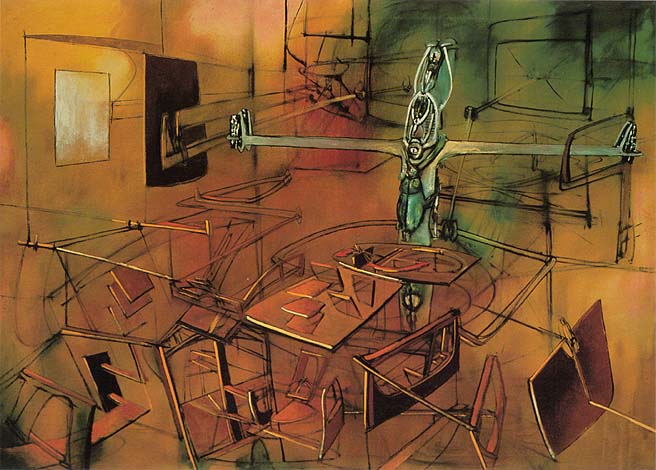Roberto Sebastián Antonio Matta Echaurren, most frequently referred to simply as "Matta", was born in Chile in 1911. Here he studied architecture before moving to Paris, where he became caught up in the Surrealist movement and began his career as an artist. Most of his early work were drawings, already marked by the unique and fascinating style that would distinguish his legacy. In 1939 he arrived in New York, along with many other artists in "exile" from Europe due to the war. Inspired by the work of his European peers and especially that of Marcel Duchamp, he began painting. His style is one that is instantly recognizable and visually arresting. It is also one defined by dualisms; fascinated by the scientific world, he drew upon cosmic imagery as well as minuscule botanical studies in old textbooks for inspiration. Having studied architecture, his work contains many straight lines and planes and grids, but these all exist in impossible positions and are outnumbered by organic curves and patches of color. Many of Matta's works not only flout conventions of space, but also of time - a number of his paintings are meant to portray a lifetime, from birth to death, or an individual, or a landscape, or a universe. He developed an individual iconography, a set of symbols that represented real-world objects as well as ideas such as movement and destiny that is consistent throughout his works. He deeply considered the role of the viewer in his art and sought to "liberate images from their common meaning and to represent the object by an image which is pliable to the mechanism of sight and expands the consciousness" (Smith and Dartnall, 24). His later works feature strange, contorted humanoid figures with very alien characteristics, and also include some pieces of an erotic nature (although a very abstract one).

Horoscope, 1937. This is one of Matta's early drawings; his use of vibrant color and stretched forms would come to be very common in his paintings. Matta sought to "depict the unseen realities underlying human existence by conjoining several phases of growth and evolution within a single image" (Smith and Dartnall, 12).
X-Space and the Ego, 1945. Another of Matta's drawings, but from later in his life, evidenced by the fact that strange humanoids are the subject. There is some sense of perspective and a horizon, but overall an unclear sense of space and position, blending dimensions into each other.
A Grave Situation, 1946. A figure is trapped in a cluttered space of planes and supports. The work is intended as a commentary on the human condition, and the central character is based on the forms of ancient totems.
Coigitum, 1972. This is my favorite work of Matta's. It has a sense of both chaos and order, and one feels that the scene could be happening on a cosmic scale, lightyears wide, or it could just as easily be occurring within a single cell. The simple color palette and mix of geometric and organic forms are extremely pleasing, and the amount of detail make it very easy to get lost in the painting.
MATTA, Centre Georges Pompidou, Musee naitonal d'art moderne, 1985. (anthology)
Matta in America, Paintings and Drawings of the 1940s, Smith and Dartnall, 2001.




It seems that it's only showing the left sides of the last two pictures; here they are in full:
ReplyDeletehttp://www.matta-art.com/popup.htm?coigitum.jpg
http://www.epdlp.com/fotos/matta1.jpg